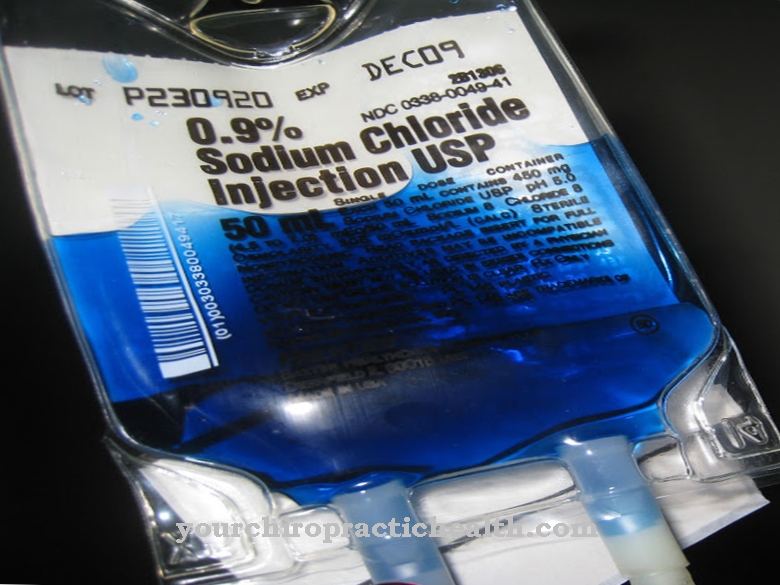Barium sulfate is a poorly soluble to insoluble sulfate salt, which is obtained from the earth potassium metal barium. In natural stocks it occurs as barite. As a powder, barium sulfate glows white. It is used as a filling in plastics for the production of colors and medicinally as an X-ray positive contrast medium.
What is barium sulfate?

Barium sulfate is a substance with a high impermeability. It is therefore used in radiology as a sparingly soluble suspension in the form of an X-ray positive contrast medium. It is not absorbed and is suitable for representing the digestive tract. The drug is then excreted unchanged as white stool.
Barium sulfate is administered as a swallow of the esophagus in order to obtain physiological information. It enters the stomach in oral form via the esophagus and is then excreted via the digestive tract. Another possibility is the rectal introduction for the extraction of morphological information.
Pharmacological effect
The barium sulfate suspensions used in X-ray diagnostics differ in terms of their viscosity, particle size and concentration. In addition to barium sulfate, isotonic agents such as sorbitol as well as thickening and dispersing agents are used to avoid flocculation (flocculation).
The contrast agent is often used in combination with methyl cellulose gels and carbon dioxide to induce inflation of the gastrointestinal tract with air. This simultaneous use of two agents is called the double contrast method. In this way, a better representation of the intestinal mucosa is achieved in relief, since the contrast agent alone only leads to a thin coating on the intestinal surface.
Contrast media are used to depict organs with the X-ray examination that have only a slight difference in density compared to the surrounding organ systems and tissues. This enables doctors to differentiate between pathological processes and healthy tissue.
Since barium sulfate suspensions are not soluble in water or fat, they are not absorbed by the body and are excreted unchanged. The toxic effect of the raw material barium metal is only very slight.
Medical application & use
Contrast media can have undesirable side effects that manifest themselves in various organs and the skin. If an X-ray examination using a contrast agent is indicated, the requirements are generally more stringent than for the therapeutic allocation of drugs. Modern X-ray contrast media undergo long-term compatibility studies before they are approved by law. Doctors are also obliged to inform their patients about the possible risks.
By using contrast media, doctors gain additional information that they would not get without imaging procedures and the use of these media. The additional information is divided into two categories: morphological (structural) and physiological (functional) information. A typical examination for the former is double-contrast imaging of the large intestine by rectal instillation (dropwise administration) of a barium suspension. The subsequent introduction of air into the intestine makes the intestinal lumen (clear width) visible through the filling and the negative contrast. This is due to the high permeability of the air for X-rays. Morphological changes such as polyps, constrictions, inflammations and bulges become visible.
Functional information is obtained by giving a swallow of porridge. In this way, doctors can determine mobility disorders in the esophagus. Due to the high white luminosity, the examined organ or tissue can be clearly distinguished from the surrounding organ and tissue structures, which remain dark on the X-ray image.
Patients must be sober for the examination, that is, they must not eat or drink anything several hours beforehand. In most cases, this contrast display is carried out in the morning when the patient has not yet had breakfast, so that he only has to go without food for a short time.
Risks & side effects
Before using this X-ray contrast agent, the attending physician must carefully weigh up the risks and benefits, as serious foreign body reactions can occur if the barium sulfate suspension gets into the wrong place.
Its use is contraindicated if there is a perforation in the stomach and intestines and there is a risk of aspiration (absorption) of the contrast medium. This is the case, for example, with fistulas or a perforated ulcer in the form of a deep-seated substance defect. In the event of this incorrect allocation, the contrast agent reaches the peritoneal organs, for example the liver, spleen, stomach, colon, uterus or ovaries (ovaries). If barium sulfate gets into the free abdominal cavity, life-threatening complications can occur.
In the case of an irrigoscopy (colon X-ray), an X-ray examination should not be performed until 14 days after the biopsy performed. Intraperitoneal administration that is not indicated can result in death of the patient. The opposite of "peritoneal" is "retroperitoneal". All organs that lie behind the abdominal cavity, such as ureters and kidneys, are primarily retroperitoneal. The organs that are connected to the dorsal abdominal wall are secondary retroperitoneal. These organs include the duodenum (small intestine following the stomach), pancreas (pancreas), and ascendus and descendus colon (ascending and descending colon).
Less dangerous and rarely occurring side effects are constipation, sweating, weakness, stomach cramps, itching, hives or reddened skin. Difficulty breathing or swallowing, hoarseness and temporary states of confusion are also possible.












.jpg)



.jpg)










.jpg)
